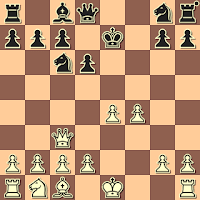I received a friendly email from Andrew Hubbard, containing a wild Jerome Gambit game .
TacticalRain - sriramv
Internet, 2020
1.e4 e5 2.Nf3 Nc6 3.Bc4 Bc5 4.Bxf7+
4...Kxf7 5.Nxe5+ Nxe5 6.Qh5+ g6 7.Qxe5 Bxf2+
When Black plays this sacrifice - here, and in other Jerome Gambit variations - his reasoning is usually one or more of the following
a) If you're going to knock my King about, I'm going to knock yours about, too;What can happen if White goes along with Black's plan is a pretty level position: 8.Kxf2 Nf6 9.Rf1 Re8 10.Qg3 Nxe4+ 11.Kg1+ Kg8 12.Qf4 d5. Should White be happy, because he no longer is two pieces down? Or, should he be disappointed, because his wild attack has dissipated? No doubt, this leads to White's choice in the game.
b) If you're going to capture my Bishop, I might as well get a pawn for it;
c) I'm going to exchange Queens, even if it leaves me a pawn down, because it will deflate your attack
8.Kd1
The same psychology in any declined gambit or counter-gambit: If you want me to take the sacrifice, then I will refuse it.
The Database has 6 earlier examples of this move, with White scoring 50%. Possibly, that is because Black did not find the strongest response.
8...Qf6
Offering the exchange of Queens, which is good enough, but the real danger came from 8...Qh4, threatening 9...Qg4 mate! This is not an idle threat - for example, if White guards the g4 square with 9.h3, then 9...d6 both attacks White's Queen and threatens 10...Bg4+ 11.hxg4 Qxg4 mate.
White can answer 8...Qh4 with 9.c3, creating an escape outlet for his King, but the situation remains dire: 9...Nf6 10.d3 Qg4+ 11.Kc2 Qxg2 12.Nd2 Qxh1, although White can recover a piece with 13.Qf4 followed by e4-e5. He can improve the line by checking the enemy King a bit, first: 9.Qd5+ Kg7 10.Qe5+ Nf6+ 11.Qe7+ Kg8 12.c3, because now 12...Qg4+ 13.Kc2 Qxg2 would lead to 14.Qxf6 Qxh1 15.Qd8+ Kf7 16.Qxh8 Qxh2 when Black would have only a small edge. However, instead of hunting material, Black improves with 12...b6 and 13...Ba6, or 12...d5 and is still better.
This is almost enough to rename this blog post "Jerome Gambit Secrets #13".
9.Qxc7
White is not seeking a draw. In the meantime, he holds up the pawn that blocks the Bishop that hems in the Rook.
9...Nh6 10.Rf1 Ng4
The Knight provides extra protection for the Bishop, while scheming to undermine the Rook; but the Black King would do better to acknowledge the danger down the f-file and move off of it with 10...Kg7.
11.d3 Nxh2
Overlooking both the fact that White's Queen protects the h-pawn and that White has a developing and attacking move to complicate things further.
12.Bg5 Qxg5 13.Rxf2+ Kg7 14.Qc3+
14...Kh6
Black's King is usually safer at home, although White grabs a piece after 14...Kg8 15.Rf8+ Kxf8 16.Qxh8+ Kf7 17.Qxh7+ Kf8 18.Qxh2. Once again, things would not be as simple as they first seem, as Black's response 18...d5 has an echo of the threat analyzed after move 8 - 19.Nd2 dxe4 and if 20.Nxe4, then 20...Bg4+ will lead to mate. White probably would do best to play 20.Qh8+ and force a draw by way of repetition.
15.Qxh8
Now things are going White's way.
15...Qg4+ 16.Re2 Nf1
A slip.
17.Qf8+ Kh5 18.Qxf1 d5
Too late to the party.
19.Nc3 dxe4 20.Nxe4 Bf5
One final Oooops.
21.Nf6+ Black resigned
Wild!




























